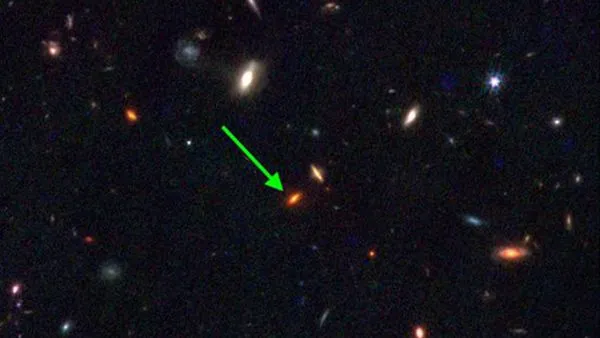The James Webb Space Telescope (JWST), humanity’s most powerful cosmic eye, has unearthed a celestial anomaly that threatens to rewrite our understanding of the universe’s early days. A massive galaxy, aptly named ZF-UDS-7329, stands accused of defying logic, boasting more stars than our Milky Way yet forming a mere 800 million years after the Big Bang – a feat that shouldn’t be possible according to current theories of galaxy formation and the enigmatic role of dark matter.
Imagine a toddler effortlessly lifting a car. That’s the level of bewilderment scientists face with ZF-UDS-7329. Standard models posit that galaxies like ours require massive halos of dark matter, the invisible substance composing 85% of the universe’s matter, to attract and hold gas and dust, the fuel for star birth. But ZF-UDS-7329 seems to have bypassed this crucial step, forming stars at an astonishing rate without the expected dark matter scaffolding.
“It’s like finding a completely different set of physics at play in the early universe,” marvels Claudia Lagos, co-author of the groundbreaking study published in Nature. “This discovery throws a wrench into our understanding of how galaxies form and evolve. It’s a paradigm shift waiting to happen.”
This isn’t the first time JWST has stumbled upon these early universe “monster galaxies”. Each discovery pushes the boundaries of cosmic timelines, forcing astronomers to re-evaluate their assumptions. Our current models, envisioning a slow, gradual process of galaxy formation, seem inadequate to explain these stellar behemoths.
One possibility is that ZF-UDS-7329 formed in a denser region of the universe, allowing it to accumulate stars rapidly without needing extensive dark matter. However, this scenario requires further investigation and may not explain all the observed anomalies.
ALSO READ: James Webb Space Telescope: Could It Detect Life on Earth from Across the Galaxy?
Another, more intriguing, possibility is that dark matter itself behaves differently in the young universe. Perhaps it clumped faster, interacted with baryonic matter in unexpected ways, or even possessed entirely different properties than we currently understand. This could rewrite our understanding of not just galaxy formation, but the very nature of dark matter itself.
“The implications are mind-boggling,” remarks Themiya Nanayakkara, another co-author. “If we can unravel the secrets behind these ‘monster galaxies’, it could rewrite our entire picture of the universe’s early history and its evolution. It’s like finding a missing puzzle piece in the cosmic story, one that could drastically change how we see the universe.”
The discovery highlights the immense potential of JWST. Its ability to peer deeper and sharper than any telescope before it allows us to witness the universe in unprecedented detail, revealing phenomena that challenge our current understanding. With further observations and analysis, ZF-UDS-7329 and its ilk could become the Rosetta Stone of the early universe, unlocking its secrets and forcing us to rewrite the story of galaxy formation, dark matter, and perhaps, even cosmology itself.
ALSO READ: Understanding Low Earth Orbit
This is just the beginning of a thrilling scientific adventure. As JWST continues to gaze into the cosmic abyss, its discoveries promise to rewrite our cosmic textbooks and reshape our understanding of the universe’s grand narrative. One thing is certain: the universe is full of surprises, and ZF-UDS-7329 is just the latest reminder that we have much to learn about its beginnings and its ultimate fate.
